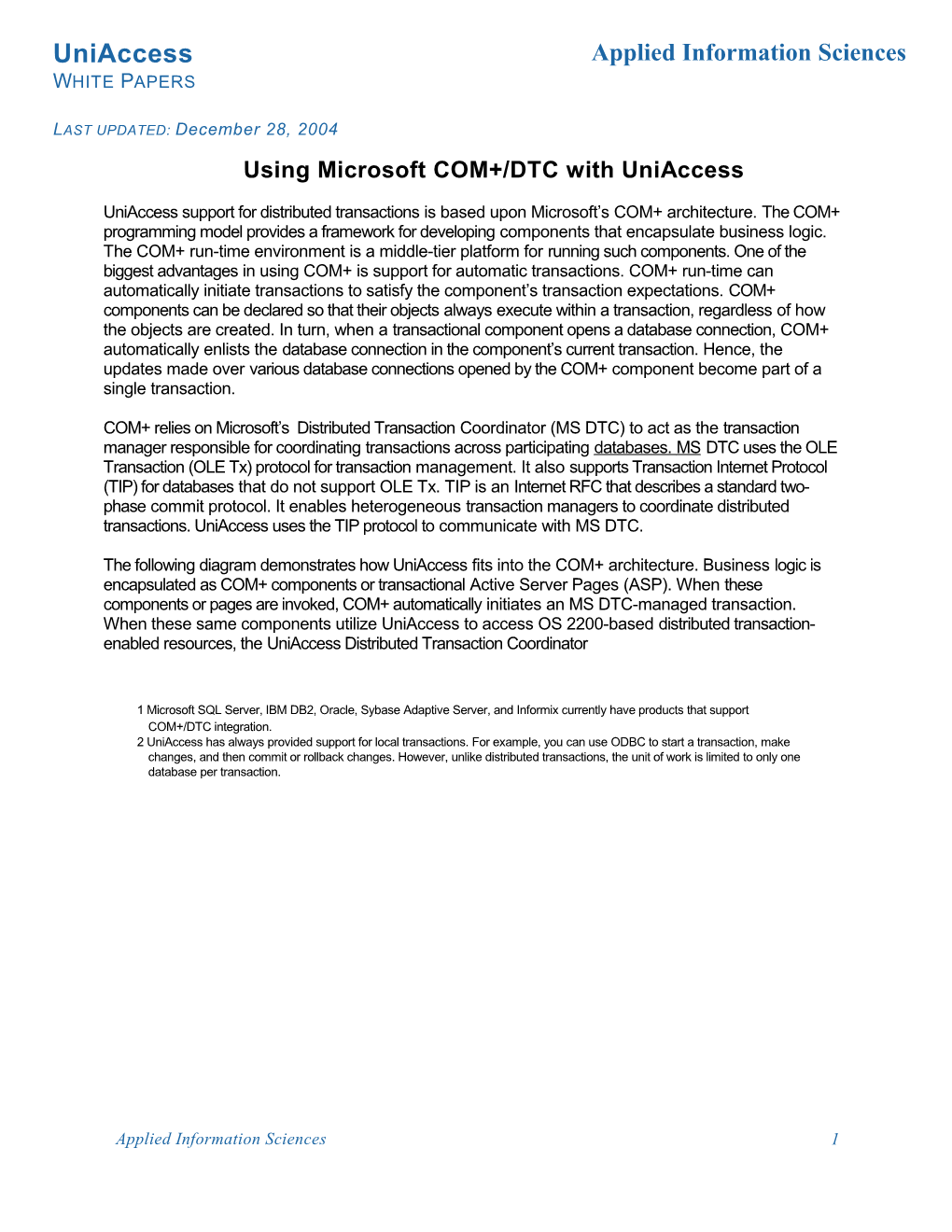Applied Information Sciences
Applied Information Sciences
1
UniAccess
WHITE PAPERS
LAST UPDATED: December 28, 2004
Using Microsoft COM+/DTC with UniAccess
UniAccess support for distributed transactions is based upon Microsoft’s COM+ architecture. The COM+ programming model provides a framework for developing components that encapsulate business logic. The COM+ run-time environment is a middle-tier platform for running such components. One of the biggest advantages in using COM+ is support for automatic transactions. COM+ run-time can automatically initiate transactions to satisfy the component’s transaction expectations. COM+ components can be declared so that their objects always execute within a transaction, regardless of how the objects are created. In turn, when a transactional component opens a database connection, COM+ automatically enlists the database connection in the component’s current transaction. Hence, the updates made over various database connections opened by the COM+ component become part of a single transaction.
COM+ relies on Microsoft’s Distributed Transaction Coordinator (MS DTC) to act as the transaction manager responsible for coordinating transactions across participating databases. MSDTC uses the OLE Transaction (OLE Tx) protocol for transaction management. It also supports Transaction Internet Protocol (TIP) for databases that do not support OLE Tx. TIP is an Internet RFC that describes a standard two-phase commit protocol. It enables heterogeneous transaction managers to coordinate distributed transactions. UniAccess uses the TIP protocol to communicate with MS DTC.
The following diagram demonstrates how UniAccess fits into the COM+ architecture. Business logic is encapsulated as COM+ components or transactional Active Server Pages (ASP). When these components or pages are invoked, COM+ automatically initiates an MS DTC-managed transaction. When these same components utilize UniAccess to access OS 2200-based distributed transaction-enabled resources, the UniAccess Distributed Transaction Coordinator
1 Microsoft SQL Server, IBM DB2, Oracle, Sybase Adaptive Server, and Informix currently have products that support COM+/DTC integration.
2 UniAccess has always provided support for local transactions. For example, you can use ODBC to start a transaction, make changes, and then commit or rollback changes. However, unlike distributed transactions, the unit of work is limited to only one database per transaction.
UniAccess
Applied Information Sciences2
(UADTC) is responsible for communicating with MS DTC via the TIP protocol and with the UniAccess OS 2200-based components to coordinate distributed transaction processing. In turn, the UniAccess OS 2200-based components rely on standard OS 2200 system facilities such as Step Control and Integrated Recovery Utility (IRU) to perform two-phased commits in response to UADTC messages.
Microsoft COM Technologies
TIP Protocol
Applied Information Sciences3
DISCLAIMER
Permission to use this document is granted, provided that (1) this permission, as well as the disclaimer and copyright notice that follow appear in all copies, (2) use of this document is for informational and non-commercial or personal use only, and (3) the document is not modified in any way.
APPLIED INFORMATION SCIENCES, INC. AND/OR ITS RESPECTIVE SUPPLIERS MAKE NO REPRESENTATIONS ABOUT THE SUITABILITY OF THE INFORMATION CONTAINED IN THIS DOCUMENT FOR ANY PURPOSE. THIS DOCUMENT IS PROVIDED "AS IS" WITHOUT WARRANTY OF ANY KIND. APPLIED INFORMATION SCIENCES, INC. AND/OR THEIR RESPECTIVE SUPPLIERS HEREBY DISCLAIM ALL WARRANTIES AND CONDITIONS WITH REGARD TO THIS INFORMATION, INCLUDING ALL IMPLIED WARRANTIES AND CONDITIONS OF MERCHANTABILITY, FITNESS FOR A PARTICULAR PURPOSE, TITLE AND NON-INFRINGEMENT. IN NO EVENT SHALL APPLIED INFORMATION SCIENCES, INC. AND/OR THEIR RESPECTIVE SUPPLIERS BE LIABLE FOR ANY SPECIAL, INDIRECT OR CONSEQUENTIAL DAMAGES OR ANY DAMAGES WHATSOEVER RESULTING FROM LOSS OF USE, DATA OR PROFITS, WHETHER IN AN ACTION OF CONTRACT, NEGLIGENCE OR OTHER TORIOUS ACTION, ARISING OUT OF OR IN CONNECTION WITH THE USE OR PERFORMANCE OF INFORMATION AVAILABLE IN THIS DOCUMENT.
THIS DOCUMENT COULD INCLUDE TECHNICAL INACCURACIES OR TYPOGRAPHICAL ERRORS. CHANGES ARE PERIODICALLY ADDED TO THE INFORMATION HEREIN. APPLIED INFORMATION SCIENCES, INC. AND/ OR THEIR RESPECTIVE SUPPLIERS MAY MAKE IMPROVEMENTS AND/OR CHANGES IN THE PRODUCT(S) AND/OR THE PROGRAM(S) DESCRIBED HEREIN AT ANY TIME.
IN NO EVENT SHALL APPLIED INFORMATION SCIENCES, INC AND/OR ITS RESPECTIVE SUPPLIERS BE LIABLE FOR ANY SPECIAL, INDIRECT OR CONSEQUENTIAL DAMAGES OR ANY DAMAGES WHATSOEVER RESULTING FROM LOSS OF USE, DATA OR PROFITS, WHETHER IN AN ACTION OF CONTRACT, NEGLIGENCE OR OTHER TORTIOUS ACTION, ARISING OUT OF OR IN CONNECTION WITH THE USE OR PERFORMANCE OF SOFTWARE, DOCUMENTS, PROVISION OF OR FAILURE TO PROVIDE SERVICES, OR INFORMATION AVAILABLE FROM THIS SERVER.
COPYRIGHT NOTICE. Copyright 2004 Applied Information Sciences, Inc., 1850Centennial Park Drive, Reston, Virginia, 20191 U.S.A. All rights reserved.
TRADEMARKS. Product and company names mentioned herein may be the trademarks of their respective owners.
Any rights not expressly granted herein are reserved.
